Here, we’ll take a closer look at diamond proportion and how it affects the radiance and beauty of these priceless jewels. We are able to make well-informed decisions regarding cut quality and diamond prices by comprehending the significance of depth, width, and table size.
In this guide to diamond proportion, we’ll also look at how slightly altered proportions can have a big effect on a diamond’s fire, brilliance, and scintillation.
Welcome to BrighterGuide, the definitive resource on diamond ratios! Prepare yourself for a fascinating voyage into the realm of diamond proportions!
Key Takeaways
- Diamond proportions, including depth, width, and table size, play a crucial role in determining a diamond’s radiance and overall beauty, making them essential factors to consider when purchasing a diamond.
- Achieving the ideal balance in factors like table size, crown angle, and pavilion angle is essential for optimizing a diamond’s ability to reflect light, enhancing its brilliance and fire.
- Various aspects, such as culet size, girdle thickness, symmetry, polish, and diamond shape, also impact diamond proportion and its overall appearance, making it important to carefully evaluate these factors when choosing a diamond for its beauty and value.
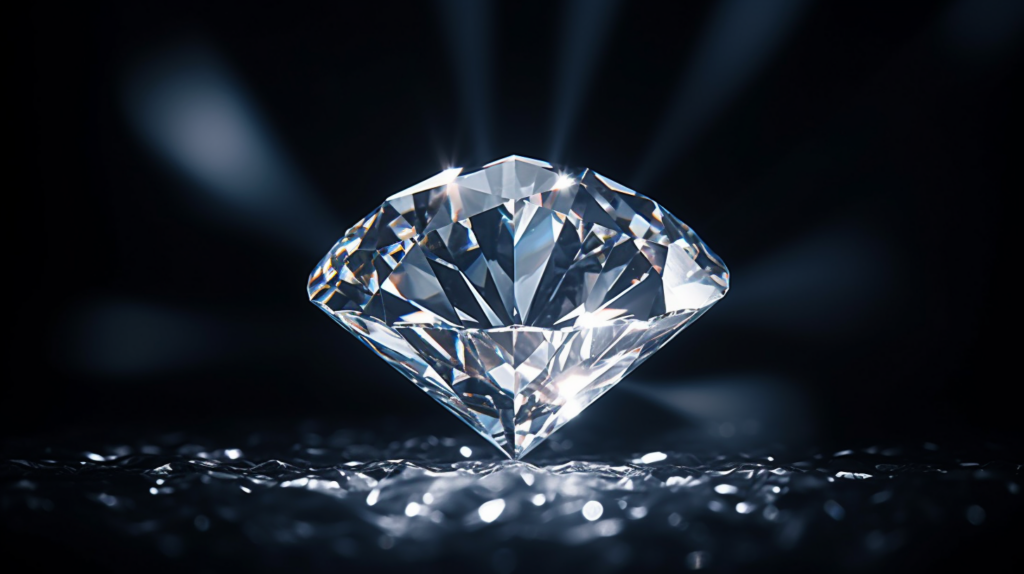
In this post, we’ll explore:
What is Diamond Proportion
When we talk about diamond proportions, we need to realize that we are talking about the size and ratio of a diamond’s depth, width, and table. The light performance and general beauty of a diamond are greatly influenced by its proportions. The ideal proportions for each diamond shape are different, so keep that in mind. In order to maximize the diamond’s ability to reflect light and create sparkle, it is imperative to achieve optimal proportions.
One important aspect of light performance is the table size or the width of the top surface of the diamond. Insufficient table size percentage may cause internal light loss in the diamond, resulting in subpar cut quality. The diamond’s ability to reflect light, however, may be compromised by a high table size percentage, which would lead to a lower cut quality. For the perfect cut, finding the ideal balance in table size is essential.
Proportionality is also greatly influenced by diamond width, which is the length of the diamond between two girdles. There are recommended values for the length-to-width ratio for various diamond shapes in order to guarantee ideal proportions. The general appearance and proportionality of a diamond are influenced by its width.
Diamond proportions also include diamond depth, which is calculated by dividing the diamond’s height by its width. Since light travels through a shallow depth percentage diamond without leaving a trace, the diamond may appear dull and uninteresting. Nonetheless, a high depth percentage may result in poor cut quality because light may not be able to pass through the diamond’s thin bottom. To ensure outstanding sparkle and brilliance, the ideal depth percentage must be reached.
How Diamond Proportion is Calculated
Three important factors are taken into account when calculating diamond proportions: the diamond table, diamond width, and diamond depth.
A diamond’s ability to reflect light is largely dependent on its table size, which is calculated by dividing the table width by the diamond’s overall diameter.
Diameter is the length of a diamond measured from one girdle to the next. It is a crucial measurement for figuring out how proportionate the diamond shape is.
The overall cut quality and appearance of the stone are greatly impacted by diamond depth, which is determined by dividing the height by the width of the diamond.
Diamond Table
While a diamond’s proportions can be determined in large part by consulting the diamond table, it’s also important to know how the ideal brilliance and beauty of a diamond are calculated. To get this knowledge, think about the following:
- Table Size Percentage: The whole diamond diameter is divided by the table width, or the largest facet or top face area, to get the table size. A low table size percentage means that the diamond’s cut quality is compromised by internal light loss. A high table size percentage, on the other hand, indicates that the diamond has poor light reflection, which leads to a low cut quality. To guarantee a diamond has the perfect cut, the table size must be reached.
- Crown Heights: The height of the crown is the separation between the table and the girdle. The diamond’s ability to reflect light and add to its overall brilliance is largely dependent on this factor. The ideal distribution and reflection of light are ensured by the proper balancing of crown height, amplifying the diamond’s brilliance and beauty.
- Pavilion Angle: The angle created by the pavilion’s main facet and girdle is known as the pavilion angle. It influences light’s path into and out of the diamond. When light is reflected back through the crown at the ideal pavilion angle, maximum brilliance and fire are produced.
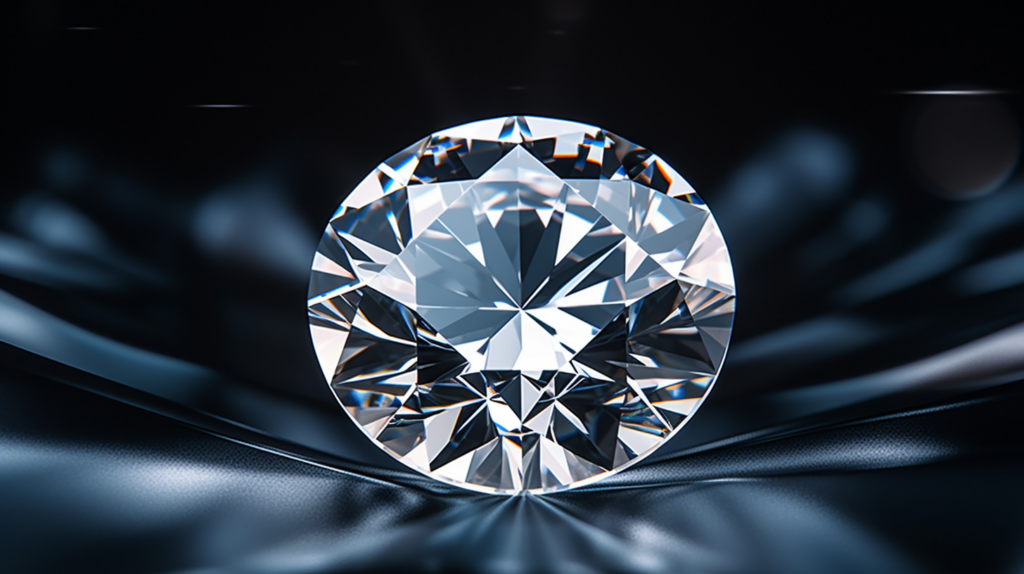
To achieve a diamond with ideal proportions, it is crucial to comprehend these computations and determine the ideal balance of pavilion angle, crown heights, and table size percentage.
Considering these aspects, let’s proceed to the following section regarding diamond width, which is also a major factor in the overall appearance and proportionality of a diamond.
Diamond Width
The diamond width is a major factor in determining the overall appearance and proportionality of the diamond, so we usually calculate diamond proportion by taking that into account. The distance between a diamond’s girdles is referred to as the diamond width.
In round diamonds, the width is equal to the diameter; in other shapes, it is a component of the ratio of length to width (L/W). This ratio shows how symmetrical a diamond shape is. To achieve ideal proportions, different diamond shapes have recommended values for the length-to-width ratio.
When assessing a diamond’s overall beauty and proportions, its width is a crucial component. It enhances the diamond’s capacity to reflect light, which in turn influences the diamond’s brilliance. The width must be taken into account when calculating diamond proportion in order to achieve a gorgeous and well-balanced look, particularly in brilliant cut diamonds.
| Diamond Shape | Recommended Length-to-Width Ratio |
| Round | 1.00 – 1.02 |
| Princess | 1.00 – 1.05 |
| Emerald | 1.30 – 1.50 |
Diamond Depth
The overall cut quality and appearance of the stone are greatly influenced by the diamond depth, which is calculated by dividing the diamond’s height by its width. There are three crucial things to consider when evaluating diamond depth:
1. Shallow depth percentage: When light passes through a diamond without leaving a trace, a diamond with a shallow depth percentage lacks brilliance and sparkle. A lower-quality cut and a less eye-catching diamond are the outcomes of this.
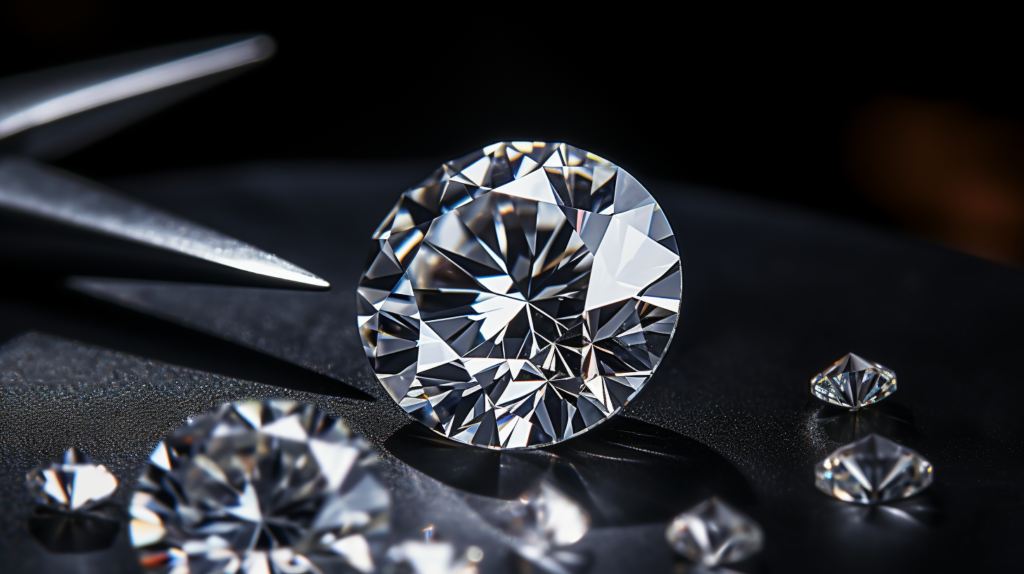
2. Deep Depth Percentage: Conversely, a diamond with a deep depth percentage provides light to pass through its thin bottom, giving the appearance of being lifeless and dull. The diamond’s cut quality is also adversely impacted by this.
3. Achieving the ideal depth percentage is essential to guaranteeing a diamond that is well-cut. It makes the diamond more beautiful overall by enabling exceptional sparkle and brilliance.
To choose a well-cut diamond with the most brilliance and beauty, one must be aware of the significance of diamond depth. Let us examine the different factors that can impact the proportion of diamonds.
Factors Affecting Diamond Proportion
There are various important things to take into account when determining the proportion of diamonds. These consist of the culet size, depth percentage, pavilion angle, table size, and crown angle.
The way a diamond interacts with light and, ultimately, determines its brilliance and beauty, is determined by each of these factors. Achieving the appropriate cut quality and enhancing a diamond’s allure requires an understanding of and emphasis on these factors.
Read more: Best Engagement Ring Guide
Table Size
The diamond’s capacity to reflect light and add to its overall brilliance is largely dependent on the size of the table. A diamond that is properly sized and proportioned will have more brilliance and scintillation. When assessing table size, keep the following three things in mind:
1. The largest facet on top of the diamond is called the table facet. The quantity of light that enters and leaves the stone is directly impacted. The table facet of a well-cut diamond will be just the right size.
2. Use diamond proportion charts as a guide to ascertain the appropriate table size percentage for various diamond shapes. For ideal proportions, a table’s size should fall within a specific range depending on the shape.
3. The diamond’s reflectivity is directly impacted by the size of the table. A magnificent visual display can be produced by maximizing the brilliance and fire of the diamond with a precisely proportioned table size.
It’s critical to comprehend how the crown angle works with the table size as we go over it in order to fully appreciate the beauty of the diamond.
Crown Angle
In order to comprehend how the crown angle affects the proportion of the diamond, we must take into account how it contributes to the brilliance and beauty of the stone.
The bezel facet and the girdle plane form an angle that is referred to as the crown angle. It contributes to the diamond’s overall brilliance and is essential to how light interacts with the stone.
A diamond with a shallow crown angle may lose some of its brilliance due to light leaking out of the stone. A steep crown angle, on the other hand, may result in internal light reflection, which would diminish brightness and give the appearance of being darker.
The diamond’s ability to reflect light and produce an amazing display of brilliance and beauty depends on achieving the ideal crown angle.
Pavilion Angle
In order to assess and optimize diamond proportions for maximum brilliance and beauty, it is essential that we comprehend the pavilion angle. Light interaction with the diamond is largely determined by the pavilion angle, which is the angle formed by the pavilion’s main facets and the girdle plane.
When it comes to the pavilion angle, keep the following three things in mind:
1. Optimal Angle: Carefully selecting the pavilion angle will guarantee that light entering the diamond is reflected back up through the crown facets, maximising its brilliance. Poor light performance or light leakage can arise from a pavilion angle that is too shallow or steep.
2. Achieving the best possible light reflection and refraction requires balancing the pavilion angle with the crown angle. The diamond’s capacity to reflect light and produce sparkle is determined by the interaction of these two angles.
3. Effect on brilliance: The diamond’s capacity to reflect light and optimize brilliance is directly impacted by the pavilion angle. The pavilion angle produces an amazing show of brilliance when it is within the optimal range, which enables the efficient capture and reflection of light.
Depth Percentage
Diamond proportion is determined by a number of factors, including the depth percentage and how it affects the overall cut quality and appearance of the stone. The depth percentage can be computed by dividing the diamond’s height by its width.
Because light passes through a shallowly positioned diamond without leaving a trace, the diamond lacks sparkle and brilliance. A deep depth percentage, on the other hand, results in a poor cut quality because light is unable to pass through the diamond’s thin bottom.
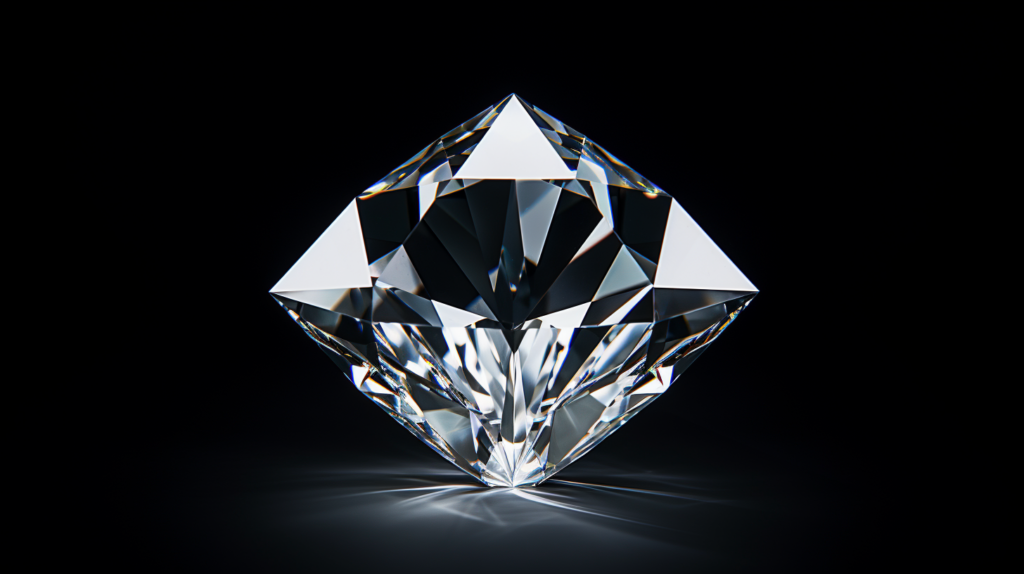
To guarantee that a diamond has exceptional brilliance and sparkle, the ideal depth percentage must be reached. The ideal diamond proportion is determined by taking into account the depth of the diamond, as it has a significant impact on the overall cut quality and appearance of the stone.
Moving on, let’s discuss the significance of culet size in the next section.
Culet Size
But when examining the variables that impact diamond proportion, we shouldn’t undervalue the importance of culet size. The small facet at a diamond’s bottom known as the culet size is a major factor in determining the stone’s overall brilliance.
Consider the following three important points:
1. Effect on light reflection: The culet’s size has an impact on how light interacts with the diamond. Reduced brilliance can occur from light leaking out of the bottom due to larger culet sizes. The sparkle and fire of the diamond are enhanced by light reflecting back through the crown when the culet size is smaller.
2. Proportion and Symmetry: The diamond’s culet size should be proportionate to its overall dimensions. It should be in harmony with the other facets and enhance the symmetry of the stone. The overall harmony and beauty of the diamond can be upset by an incorrectly sized culet.
3. Personal Preference: The size of the culet is also a subjective choice. A larger culet is preferred by some people for an antique or vintage style, while a smaller culet is preferred by others for a more streamlined and modern appearance.
To maximize brilliance and beauty, it is imperative to take into account the significance of culet size in achieving optimal diamond proportion.
Also read: Finding the Perfect Engagement Ring: A Guide to the Best Places to Buy
Girdle Thickness
Because girdle thickness is so important in defining the overall cut quality and brilliance of the stone, we cannot ignore its effect on diamond proportion. Divided into the pavilion (bottom) and crown (top) sections, the girdle is the widest portion of the diamond. The girdle facets, which make up this composition, are a collection of tiny facets. The diamond’s dimensions and the way light interacts with the stone are both impacted by the girdle’s thickness.
The appearance and brilliance of the diamond may be affected by a thick girdle, whereas a thin girdle may make the stone more prone to chipping. Achieving the ideal diamond proportion requires striking the correct balance in girdle thickness.
| Girdle Thickness | Impact on Diamond Proportion |
| Thin | Vulnerable to chipping |
| Medium | Balanced proportions |
| Thick | Impacts appearance and brilliance |
Understanding the impact of girdle thickness is vital in creating a diamond that reflects light beautifully. From the girdle thickness, we will now move on to discussing the role of symmetry in diamond proportion.
Symmetry
A crucial aspect of diamond proportion to take into account is its symmetry, which has a significant effect on the stone’s overall look and brilliance. A diamond is said to be symmetrical when its facets are properly positioned and balanced, enabling uniform light reflection throughout the stone.
The following three ideas about symmetry and how it affects diamond proportion are crucial to comprehend:
1. A diamond’s symmetry has an impact on its light-reflection capacity. A symmetrical and well-balanced diamond works better in terms of light performance, giving it more brilliance and sparkle.
2. A diamond that is symmetrical looks more aesthetically pleasing to the eye, which adds to its overall beauty. The facets’ symmetry gives the stone a balanced, harmonious appearance that adds to its overall beauty.
3. Value of the diamond is influenced by symmetry: excellently symmetric diamonds command a premium price in the market. The diamond becomes more valuable due to its increased rarity and desirability as a result of the skill and precision needed to achieve symmetrical proportions.
Polish
Let us examine how polish, which is one of the variables that affect the proportion of the diamond, is essential to bringing out the brilliance and overall beauty of the stone.
Polish describes the smoothness and luster of the diamond’s facets, specifically the quality of the surface finish. A polished diamond has fewer flaws on its surface and reflects light better, giving it more brilliance and beauty.
An exceptionally polished diamond maximizes the amount of sparkle and scintillation it can produce by allowing light to pass through the stone smoothly. A poorly polished diamond, on the other hand, may have obvious pits, scratches, or dull spots that detract from the stone’s overall beauty.
In order to maximize a diamond’s brilliance and optimize its proportions, a high level of polish is necessary.
We’ll talk about the significance of diamond shape in terms of proportion and overall appearance in the following section.
Shape
A diamond’s proportions and overall appearance are significantly influenced by its shape. A number of factors influence the stone’s proportion when it comes to diamond shape:
- Diamonds with fancy shapes are any diamonds that have a shape other than round. Princess, emerald, oval, and marquise are examples of common fancy shapes. To achieve the best possible beauty and sparkle, each shape has specific proportion requirements.
- Size of a diamond: A diamond’s size can affect its proportion. When comparing larger diamonds to smaller diamonds, different proportion requirements usually apply. When figuring out the diamond’s proportions, it’s crucial to take its size into account.
- Brilliant diamond: A diamond’s brilliance is largely determined by its size. A diamond’s ability to reflect and refract light can be improved, giving it a sparkly appearance, depending on the ideal combination of table size, depth, and other elements.
Ideal Cut Diamond Proportions
Maximizing the brilliance and beauty of a diamond requires achieving ideal cut diamond proportions. The size, ratio, and table of a diamond are referred to as its proportions. These ratios are important because they affect how well the diamond reflects light, which in turn affects its fire, brilliance, and scintillation. As diamond cutters, we are aware of how crucial it is to obtain the perfect diamond proportions in order to produce a gem that is both incredibly beautiful and enticing.
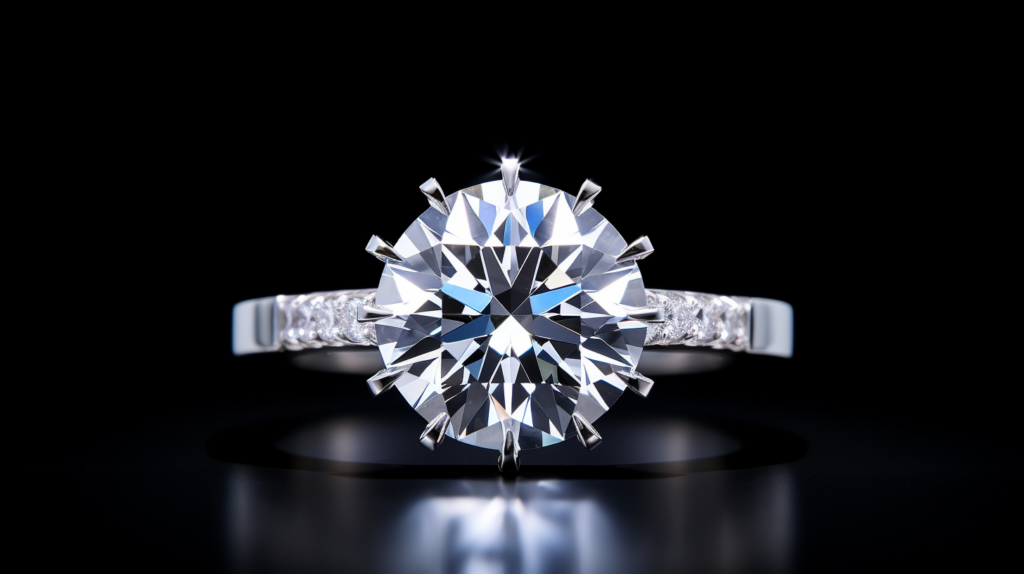
Let us examine the following table to help you comprehend the importance of diamond proportions:
| Crown Angle Options | Pavilion Angle Options | Table Options | Depth Options |
| 31.1 | 40.0 | 54% | 62.6% |
| 31.2 | 40.1 | 55% | 62.6 – 62.7% |
| 31.3 | 40.2 | 56% | 62.8 – 63.1% |
| 31.4 | 40.3 | 57% | 63.1 % |
The options available to diamond cutters are far greater than these measurements. To achieve the perfect diamond proportions, each measurement must be carefully planned and carried out with accuracy.
We can produce a diamond with outstanding brilliance and optimal light reflection by making sure the pavilion angle, table size, depth percentage, and crown angle are all within the suggested range. These measurements establish the diamond’s overall cut quality, which in turn affects the stone’s beauty and worth.
Tips for Choosing the Best Cut in a Diamond
To make sure you choose the ideal diamond cut for your intended brilliance and beauty, we advise weighing at least three different options. Here are three crucial pointers to assist you in selecting the ideal cut for your diamond:
1. Observe the pavilion depth: This is the distance measured between the culet and the bottom of the diamond’s girdle. For the best possible light reflection and refraction inside the diamond, the pavilion depth must be properly proportioned. It is advised to select a pavilion depth from the wide range of available options.
2. Examine a steeper crown angle: The diamond’s crown angle is the angle formed by the girdle and table. Because light can reflect internally and disperse more efficiently with a steeper crown angle, the diamond’s brilliance and fire can be increased. To make a diamond look more dazzling, it’s best to look into diamonds with a steeper crown angle.
3. Investigate a wide range of options: It is critical to investigate a wide range of options in order to find the ideal cut for your diamond. Variations in pavilion depth, crown angle, and other elements can produce different degrees of beauty and brilliance. You can compare and select the cut that best fits your needs and budget by taking into account a variety of options.
Conclusion
In summary, the different facets of diamond proportion and its impact on a diamond’s overall brilliance and beauty have been discussed.
The depth, width, and table ratios and sizes in a diamond are called its diamond proportion. Buyers can verify the cut quality and make knowledgeable decisions about the diamond price by using an understanding of diamond proportions to determine the amount and quality of sparkle in diamonds.
The significance of diamond proportions in influencing fire, brilliance, and scintillation has been explored in relation to a jewel’s ability to directly reflect light. The cut quality and diamond cost are primarily determined by proportions. To ascertain the total quality of the stone, precise computations of the diamond’s proportions are necessary.
The process of calculating a diamond’s proportions involves determining the ratio of a diamond’s table size, pavilion depth, and crown height to its overall length or diameter. In addition, we have covered how the diamond’s depth, width, and table size affect its brilliance overall by influencing how well the diamond reflects light.
Sources
BrighterGuide is dedicated to providing accurate and relevant information as you explore the wonderful world of diamonds and jewelry. To this end, our writers refer to primary information sources in building each article that appears on this website. These include, but are not limited to, published news articles, government portals, research papers, and more.
- Gemological Institute of America. (n.d.). Gemological Institute Of America | All About Gemstones – GIA. https://www.gia.edu/
- International Gem Society LLC. (2022, October 19). International Gem Society IGS – Information and educational services for everyone interested in gemstones. International Gem Society. https://www.gemsociety.org/